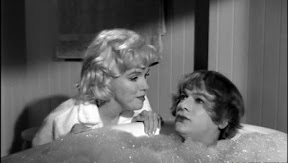Mastering every single genre just wasn’t enough for master writer/director Billy Wilder
Although he managed to help – perhaps accidentally – inspire at least three subgenres of his own as one of American cinema’s unintentional forefathers of firework-banter-filled Film Noir (Double Indemnity), unflinching addiction drama (The Lost Weekend
Needless to say, by the time he began scripting his upcoming ‘59 production alongside longtime collaborator I.A.L. Diamond, Billy Wilder wasn’t going to let a little thing like David O. Selznick telling him, “you cannot combine comedy with murder” stop him from doing just that and more – putting everything and the kitchen sink (character, genre, and plot-wise) – into the Oscar winning classic, Some Like It Hot
Yet as daring as it was to set the first act of a comedy film against the backdrop of the St. Valentine’s Day Massacre which sends our two musician leads scrambling for new identities and a new location after witnessing the roaring twenties gangland hit, in retrospect, the gunfire in Chicago should’ve been the least of Selznick’s fears about Hot.
A cross-dressing comedy that’s also a period movie, Jack Lemmon and Tony Curtis ditch the gangsters in favor of drag, seeking solace in stockings as female imposters hiding out in a Florida resort as part of an all-girl band.
And although it opens like an action flick, once George Raft’s gun and grit are replaced by the giggles and gams of Marilyn Monroe, Hot gets a lot of mileage out of double-entendre banter, segueing into a mistaken-identity road movie fueled by flirtatious, freewheeling fun.
Of course predictably, their charade catches up with them to farcical effect when Raft’s Capone-like ‘Spats’ Columbo and his wiseguy cronies head south for winter and find themselves at the exact same resort (with California’s Hotel Del Coronado standing in for the Florida location).
However what was in fact based on a ’51 German remake of a ’35 French film and could’ve also turned into a stagey update of the British classic play Charley’s Aunt
While it isn’t as eye-opening as Tootsie
Still, in a priceless romantic subplot that “mirrors” the main one (as if using a carnival funhouse mirror to go for far more daring, subversive-for-the-time laughs), Lemmon and former silent film star Joe E. Brown easily steal the picture away from the rest.
And even though Wilder’s moviemaking career was filled with superlative movie-closing lines, Some Like It Hot
But as scandalous as it was for the subject matter, which found Hot condemned by the Roman Catholic Church’s National Legion of Decency and screened without being approved by the MPAA, it was a cinematic gamble as well, given that due to the green effect of the men’s makeup the film was shot in black-and-white and released in the era of lush Cinemascope, VistaVision, and Technicolor.
Yet while the shadowy cinematography helped soften the makeup lines needed for us to suspend-our-disbelief just enough to "buy" Lemmon and Curtis as men in drag pulled off successfully enough to fool the women onscreen, the smoldering effect that the black-and-white visuals had on Marilyn Monroe caused the screen goddess to sizzle even Hotter.
Oscar winning costume designer Orry-Kelly's nearly-nude, bosom-accentuating, curve-clinging transparent little black dress (along with its flesh-toned twin that photographs nearly white) may not have been as scandalous as the siren's oft-cited skirt-flying subway grate shot captured in Wilder's Seven Year Itch
Infectiously entertaining yet impossible to define as a work of any one specific type, although it was named the single greatest American comedy movie of all time by the AFI, upon closer inspection, even that label limits the scope of the film as anything other than a Billy Wilder movie
Some Like It History:
Arthur Miller on Marilyn Monroe*
Arthur Miller on Marilyn Monroe*
“Everything she did, she played realistically. I don’t think she knew any other way to play anything – only to tell you the truth. She was always psychologically committed to that person as a person, no matter what the hell it was, rather than as a stock figure. Because the parts she got could easily have been stock figures, which had no other dimension…”
“I thought she had the potential for being a great performer if she were given the right stuff to do. And if you look at the stuff she did do, it’s amazing that she created any impression at all because most of it was very primitive. And the fact that people remember these parts from these films is amazing... She was committed to these parts as though they were real people, not cardboard cutouts.
"Even though the director and author and the rest might have thought they were cutouts and would deal with them that way. The way the two men [Tony Curtis, Jack Lemmon] in Some Like It Hot
* As Quoted in the “Marilyn Monroe” chapter of Who the Hell’s In It
As Quoted in the “Marilyn Monroe” chapter of Who the Hell’s In It by author Peter Bogdanovich in the 2005 Ballantine Books Trade Paperback Edition of his ’04 work.
by author Peter Bogdanovich in the 2005 Ballantine Books Trade Paperback Edition of his ’04 work.
Text ©2011, Film Intuition, LLC; All Rights Reserved. http://www.filmintuition.com Unauthorized Reproduction or Publication Elsewhere is Strictly Prohibited and in violation of the Digital Millennium Copyright Act.
FTC Disclosure: Per standard professional practice, I received a review copy of this title in order to evaluate it for my readers, which had no impact whatsoever on whether or not it received a favorable or unfavorable critique.


























